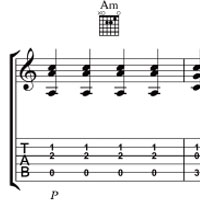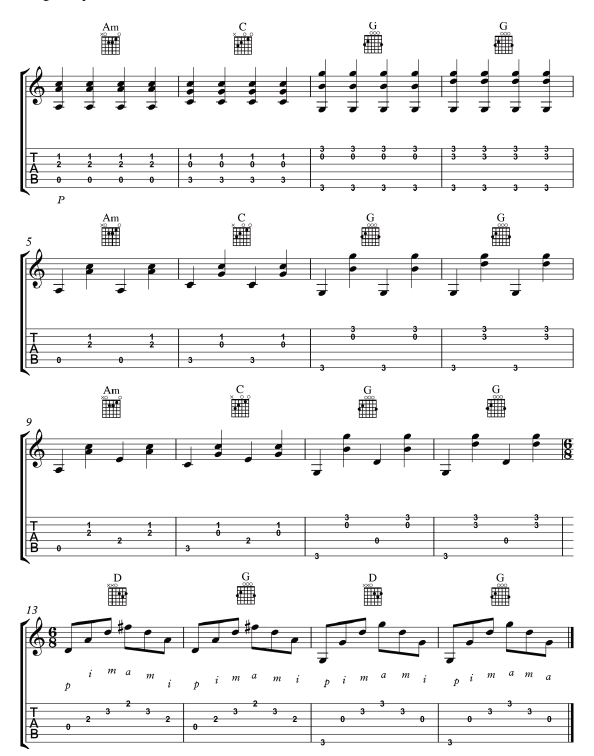Introduction To Finger Picking
Hand Position
Any seasoned, acoustic guitarist will tell you about the perils of tendonitis and RSI, but it’s not just the professionals that can suffer.
The best way to avoid these issues is to get a correct and comfortable technique right from the start. There are a few rules with hand position that apply for both hands; firstly if it doesn’t feel comfortable don’t do it!
New idea’s may feel unfamiliar but avoid huge stretches or extreme wrist angles, because you will almost always find that there is a more comfortable way of doing things such as changing the fingering of that chord.
Secondly, just like any exercise, warm up and warn down, ten minutes of scales or simple familiar exercises at a slow tempo before you start will increase your stamina, muscle memory and avoid any strains making playing uncomfortable.
Though some famously heavy handed players may disagree, keep everything light. Firstly hitting the strings harder puts more strain on your hands and wrists and is unnecessary, and secondly one tell tell sign of an experienced player is a good understanding and use of dynamics. It’s one of the beautiful things about guitar, and by playing quite lightly, there’s room to increase volume and attack when you want a passage to sound more dynamic.
Try this, hold a chord as you normally would and keep strumming it. Now without lifting your fingers from the strings, gradually decrease the pressure your using in your left hand until you start to get a buzzing sound. Now the amount of pressure you were using on that last strum before the buzz is the minimum amount needed to play that chord. Is it lighter than you normally hold the guitar? Thought so! Keeping this in mind makes changing between chords smoother. A similar approach can be applied to the right hand.
A good starting point for the left hand is to assume a “one finger per fret” hand position, i.e if your index finger is playing the first fret, your little finger should be hovering over the fourth.
With your right hand, experiment to find your own comfortable hand position but avoid strain on the wrist and try and keep your hand loose. It can be tempting to tense up but not only will this be uncomfortable, your playing will not sound as smooth as you want it to.
Finally, a few words on how acoustic guitars work. Strum an open chord, and whilst this chord is ringing out place your hand flat against the body just behind the bridge. You should notice that the sound has changed slightly, becoming slightly more muffled. The top of an acoustic guitar vibrates as you play as the sound waves flow through it. If your hand or wrist is contact with the top of the guitar you are going to deaden the guitar slightly. It’s also going to limit your playing. You will notice in the video that my hand is hovering over the strings and each finger is resting on the string it’s about to play, or just over the string that is ringing out. Lightly touching the string with your right hand finger will stop any note ringing and in turn stop notes ringing into each other, making everything much clearer.
Welcome to this introduction to finger style acoustic guitar; a playing style that has found it’s way into every genre of music.
Whether it be as an accompanist or solo player, finger picking is a dynamic technique without limitation.
Above, and in the video, I have laid out some simple exercises reminiscent of how I got into the style, over ten years ago.
These exercises are designed to be fluid, giving you a chance to put your own mark on them. Once you can play them to a standard you are happy with, take the same right hand patterns and apply them to any chord sequence you like, or start mixing up the order your finger pluck the strings in.
It will take some time to find the right hand position that’s most comfortable for you and to build dexterity, particularly in your ring finger, which isn’t used to doing anything.
Repetition and time spent with the instrument is key here. Muscle memory will be your biggest friend with your favourite finger patterns becoming automatic; just don’t get stuck in the same few patterns!
The rolling arpeggio exercise uses the conventional way of showing which fingers to use as follows PIMA. P= Thumb, I = Index , M = middle, A = ring
Mixing pinching, strumming and rolling techniques will give your playing rhythmic variety and depth.
Experimentation is key to having fun and getting the most out of finger style guitar. Try growing your right hand finger nails out for a little more clarity and attack. Finally, to understand more about this technique,
like many others, you have to study the great players of the style, whether it be classic blues players or modern acoustic soloists.
Have fun.





